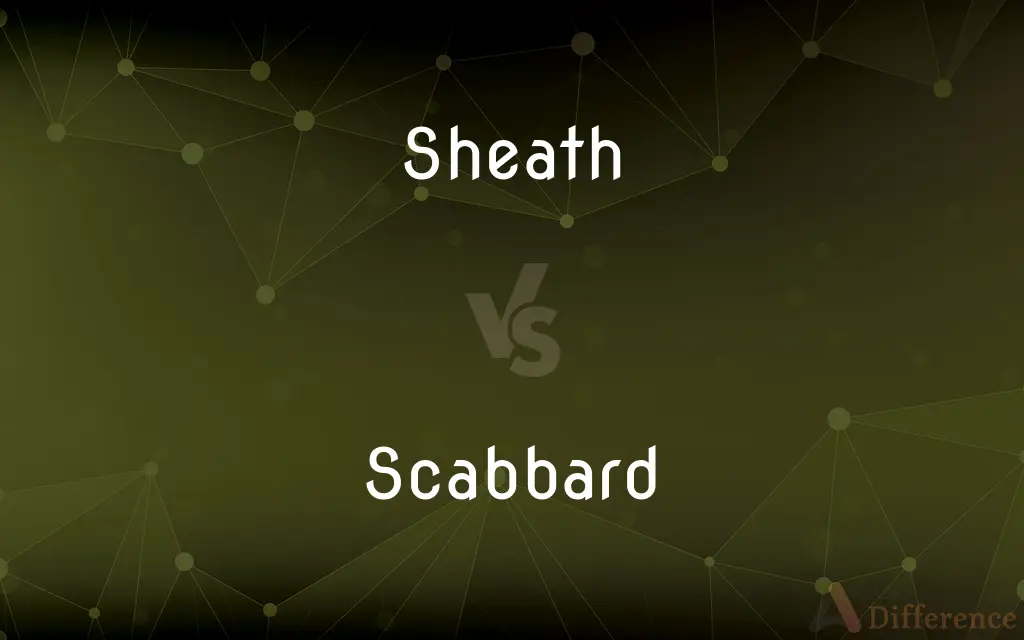Sheath vs. Scabbard — What's the Difference?
Edited by Tayyaba Rehman — By Fiza Rafique — Updated on October 29, 2023
A sheath is a protective covering, often for knives; a scabbard is specifically for swords or larger blades.

Difference Between Sheath and Scabbard
Table of Contents
ADVERTISEMENT
Key Differences
A sheath generally refers to a protective covering or case for a blade, tool, or instrument. It is a more generalized term that can encompass various items, from knives to medical instruments. The purpose of a sheath is to safeguard the blade or tool, protecting both the user and the object inside. Scabbard, on the other hand, is a term that's much more specific in its application. It's designed primarily for swords or larger blades. The history and cultural significance of the scabbard differ from that of the sheath due to its association with warfare and ceremonial purposes.
While a sheath can be made from various materials, including leather, fabric, or plastic, its design is usually straightforward and functional. It serves the primary purpose of ensuring safety and portability. A scabbard is not just a protective covering but can often be ornate, showcasing intricate designs, metals, and decorations. Given its history with knights and warriors, a scabbard could often indicate rank or achievements.
In everyday usage, the term sheath might be more commonly encountered. You'd hear it used in contexts outside of weaponry, for example, in medical or crafting scenarios. A scabbard, due to its specialized function, would be less frequently used in daily conversation unless one is discussing historical weaponry, reenactments, or specific types of martial arts.
From a linguistic perspective, the word sheath has Old English roots, derived from "sceath," meaning a division or split, implying something that can hold or cover. The word scabbard, meanwhile, is of unknown origin but made its way into Middle English, possibly from Old French “escauberc.”
In summary, while both sheath and scabbard serve to protect blades, the sheath is a more general term, and the scabbard is specifically associated with swords, often carrying historical and cultural significance.
ADVERTISEMENT
Comparison Chart
Application
General protective covering for various tools/blades
Specifically designed for swords/larger blades
Common Usage
Everyday contexts; medical, crafting, etc.
Historical weaponry, martial arts, reenactments
Design
Often simple and functional
Can be ornate with intricate designs
Material
Leather, fabric, plastic, etc.
Often metal, leather, with decorations
Etymology
Derived from Old English "sceath"
Possibly from Old French “escauberc”
Compare with Definitions
Sheath
An enveloping structure in plants, such as the base of a grass leaf.
The sheath of the plant was noticeably green.
Scabbard
A protective cover for a sword.
The knight drew his weapon from its scabbard.
Sheath
A protective cover for a blade or tool.
She placed the knife back into its sheath.
Scabbard
An ornate holder for ceremonial or decorative blades.
The ornate scabbard was studded with jewels.
Sheath
A structure in living organisms protecting a core or essential part.
The sheath around the nerve was damaged.
Scabbard
A sheathing for large blades in historical contexts.
The samurai's scabbard was made of lacquered wood.
Sheath
A close-fitting covering or case.
The cables were encased in a rubber sheath.
Scabbard
A symbol of rank or position in certain cultures.
The intricacy of the scabbard indicated his high rank.
Sheath
A close-fitting cover for the blade of a knife or sword.
Scabbard
An elongated protective covering for weapons in warfare.
He attached the scabbard to his belt, ready for battle.
Sheath
A usually close-fitting case or covering for a blade, as of a sword.
Scabbard
A scabbard is a sheath for holding a sword, knife, or other large blade. As well, rifles may be stored in a scabbard by horse riders.
Sheath
Any of various similar coverings.
Scabbard
A sheath for the blade of a sword or dagger, typically made of leather or metal
A ceremonial sword hung at his side in a gilded scabbard
Sheath
(Biology) An enveloping tubular structure, such as the base of a grass leaf that surrounds the stem or the tissue that encloses a muscle or nerve fiber.
Scabbard
A sheath, as for a dagger, sword, or rifle.
Sheath
A close-fitting dress.
Scabbard
To put into or furnish with such a sheath.
Sheath
A condom.
Scabbard
The sheath of a sword.
Sheath
A holster for a sword; a scabbard.
Scabbard
To put an object (especially a sword) into its scabbard.
Suddenly he scabbarded his sabre.
Sheath
(by extension) Anything that has a similar shape to a scabbard that is used to hold an object that is longer than it is wide.
Scabbard
The case in which the blade of a sword, dagger, etc., is kept; a sheath.
Nor in thy scabbard sheathe that famous blade.
Sheath
(botany) The base of a leaf when sheathing or investing a branch or stem, as in grasses.
Scabbard
To put in a scabbard.
Sheath
(electrical engineering) The insulating outer cover of an electrical cable.
Scabbard
A sheath for a sword or dagger or bayonet
Sheath
(entomology) One of the elytra of an insect.
Sheath
(fashion) A tight-fitting dress.
Sheath
(zoology) The foreskin of certain animals (for example, dogs and horses).
Sheath
A condom.
Sheath
Alternative spelling of sheathe
Sheath
A case for the reception of a sword, hunting knife, or other long and slender instrument; a scabbard.
The dead knight's sword out of his sheath he drew.
Sheath
Any sheathlike covering, organ, or part.
Sheath
A protective covering for a knife or sword
Sheath
An enveloping structure or covering enclosing an animal or plant organ or part
Sheath
A dress suitable for formal occasions
Common Curiosities
Are scabbards typically ornate?
Scabbards can often be ornate, especially those used in ceremonial or historical contexts.
What is a sheath primarily used for?
A sheath is primarily used as a protective covering for various tools or blades.
Is a scabbard the same as a sheath?
No, while a sheath is a general protective cover, a scabbard is specifically for swords or larger blades.
Which term is more commonly used in daily language?
"Sheath" is more commonly used in everyday language due to its broader applications.
Can a sheath be used for items other than weapons?
Yes, sheaths can be used for medical instruments, crafting tools, and more.
What materials are sheaths typically made from?
Sheaths can be made from leather, fabric, plastic, and other materials.
Are scabbards always made of metal?
No, while some scabbards feature metal, they can also be made of leather, wood, or other materials.
Can you use "scabbard" for a small pocket knife?
Typically, no. A scabbard is usually reserved for swords or larger blades.
Are sheaths and scabbards only functional?
While primarily functional, they can also have aesthetic, symbolic, or ceremonial importance.
What's an example of a sheath in nature?
The base of a grass leaf can be referred to as a sheath.
Do both sheath and scabbard originate from English?
"Sheath" has Old English roots, while "scabbard" possibly comes from Old French.
Is a sheath only for sharp objects?
Not necessarily; while often used for blades, sheaths can also cover other tools or items.
Can the word "sheath" refer to biological structures?
Yes, "sheath" can refer to structures in living organisms that protect a core or essential part.
Is a scabbard a symbol of status in any culture?
Yes, in certain cultures, the design and decoration of a scabbard can indicate rank or achievements.
Why might someone want an ornate scabbard?
For ceremonial purposes, to display rank, or for historical reenactments.
Share Your Discovery

Previous Comparison
Slush vs. Smoothie
Next Comparison
Remain vs. RemainsAuthor Spotlight
Written by
Fiza RafiqueFiza Rafique is a skilled content writer at AskDifference.com, where she meticulously refines and enhances written pieces. Drawing from her vast editorial expertise, Fiza ensures clarity, accuracy, and precision in every article. Passionate about language, she continually seeks to elevate the quality of content for readers worldwide.
Edited by
Tayyaba RehmanTayyaba Rehman is a distinguished writer, currently serving as a primary contributor to askdifference.com. As a researcher in semantics and etymology, Tayyaba's passion for the complexity of languages and their distinctions has found a perfect home on the platform. Tayyaba delves into the intricacies of language, distinguishing between commonly confused words and phrases, thereby providing clarity for readers worldwide.














































